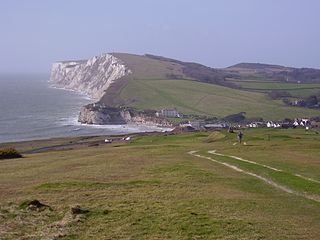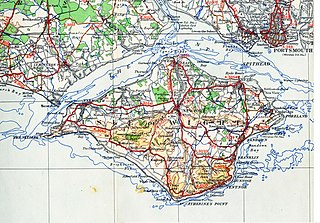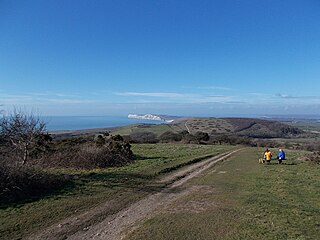
The Isle of Wight is an island, English county and unitary authority in the English Channel, 2 to 5 miles off the coast of Hampshire, across the Solent. It is the largest and second-most populous island in England. Referred to as "The Island" by residents, the Isle of Wight has resorts that have been popular holiday destinations since Victorian times. It is known for its mild climate, coastal scenery, and verdant landscape of fields, downland, and chines. The island is historically part of Hampshire. The island is designated a UNESCO Biosphere Reserve.

Alfred Tennyson, 1st Baron Tennyson was an English poet. He was the Poet Laureate during much of Queen Victoria's reign. In 1829, Tennyson was awarded the Chancellor's Gold Medal at Cambridge for one of his first pieces, "Timbuktu". He published his first solo collection of poems, Poems, Chiefly Lyrical, in 1830. "Claribel" and "Mariana", which remain some of Tennyson's most celebrated poems, were included in this volume. Although described by some critics as overly sentimental, his verse soon proved popular and brought Tennyson to the attention of well-known writers of the day, including Samuel Taylor Coleridge. Tennyson's early poetry, with its medievalism and powerful visual imagery, was a major influence on the Pre-Raphaelite Brotherhood.

Emily Sarah Tennyson, Baroness Tennyson, known as Emily, Lady Tennyson, was the wife of the poet Alfred, Lord Tennyson, and an author and composer in her own right. Emily was the oldest of three daughters, raised by a single father, after her mother Sarah died when she was three years old. Her father, a successful lawyer, was devoted to her and her sisters and ensured that they had a good education. She met Alfred when she was a girl, but they did not develop a romantic relationship until his brother Charles married her sister Louisa. It was thirteen years before they would marry, due to her father's concerns about the degree to which Tennyson could provide for her on a poet's salary. When his career became more successful, Emily and Alfred married.

Hallam Tennyson, 2nd Baron Tennyson, was a British aristocrat who served as the second governor-general of Australia, in office from 1903 to 1904. He was previously Governor of South Australia from 1899 to 1902.

Yarmouth is a town, port and civil parish in the west of the Isle of Wight, off the south coast of England. The town is named for its location at the mouth of the small Western Yar river. The town grew near the river crossing, originally a ferry, which was replaced with a road bridge in 1863.

Freshwater is a large village and civil parish at the western end of the Isle of Wight, England. The southern, coastal part of the village is Freshwater Bay, named for the adjacent small cove. Freshwater sits at the western end of the region known as the Back of the Wight or the West Wight, a popular tourist area.

Carisbrooke is a village on the south western outskirts of Newport, in the civil parish of Newport and Carisbrooke, Isle of Wight, England. It is best known as the site of Carisbrooke Castle. It also has a medieval parish church. St Mary's Church, began as part of a Benedictine priory established by French monks about 1150. The priory was dissolved by King Henry V of England in 1415 during the French Wars. In 1907 the church was restored. Its has a 14th century tower rising in five stages with a turret at one corner and a battlemented and pinnacled crown.

Totland is a village, civil parish and electoral ward on the Isle of Wight. Besides the village of Totland, the civil parish comprises the western tip of the Isle of Wight, and includes The Needles, Tennyson Down and the hamlet of Middleton.

Chapel House, now No. 15, Montpelier Row, Twickenham, is a house in Greater London, England. The house has also been called Tennyson House and Holyrood House. It was occupied at one time by Alfred Tennyson, and poet Walter de la Mare lived in the same row nearly a hundred years later. The house was owned for many years by musician Pete Townshend, principal songwriter of The Who.

Pontins is a British company operating holiday parks in the UK, founded in 1946 by Fred Pontin. It was acquired by Britannia Hotels in 2011.
Sir Frederick William Pontin was the founder of Pontins holiday camps and one of the two main entrepreneurs in the British holiday camp business in the 30 years after World War II, alongside Billy Butlin.

Blackdown, or Black Down, summit elevation 279.7 metres (918 ft) AMSL, is the highest point in both the historic county of Sussex and the South Downs National Park. It is one of the highest points in the south east of England, exceeded by Walbury Hill, Leith Hill and Pilot Hill. Blackdown is protected as part of the South Downs National Park.

Tennyson Down is a hill at the west end of the Isle of Wight just south of Totland. Tennyson Down is a grassy, whale-backed ridge of chalk which rises to 482 ft/147m above sea level. Tennyson Down is named after the poet Lord Tennyson who lived at nearby Farringford House for nearly 40 years. The poet used to walk on the down almost every day, saying that the air was worth 'sixpence a pint'.

There are several modes of Transport on the Isle of Wight, an island in the English Channel.

The Isle of Wight Coastal Path is a circular long-distance footpath of 70 miles (113 km) around the Isle of Wight, UK. It follows public footpaths and minor lanes, with some sections along roads.

St Agnes' Church, Freshwater is a parish church in the Church of England located in Freshwater, Isle of Wight.

The Tennyson Trail is a 14-mile walk from Carisbrooke to The Needles on the Isle of Wight. The route goes through Bowcombe Down, Brighstone Forest, Mottistone Down, Brook Down, Afton Down, Freshwater Bay, Tennyson Down, and West High Down to Alum Bay. The name of the trail comes from poet Alfred Lord Tennyson, a former resident of the Isle of Wight.
Warner Leisure Hotels is a hospitality company owning 14 country and coastal properties around the UK in North Wales, Somerset, Herefordshire, Berkshire, North Yorkshire, Nottinghamshire, Isle of Wight, Suffolk, Hampshire and Warwickshire. Founded in 1932 as Warner Holiday Camps, later known as Warner Holidays and has been adult only since 1994. In the 1990s Warner's started developing country house hotels and changing their existing 'camps' into coastal resorts and hotels.

Audrey Georgiana Florence Tennyson, Baroness Tennyson was a British letter-writer, hospital founder and vice-regal wife to the Governor-General of Australia.



















